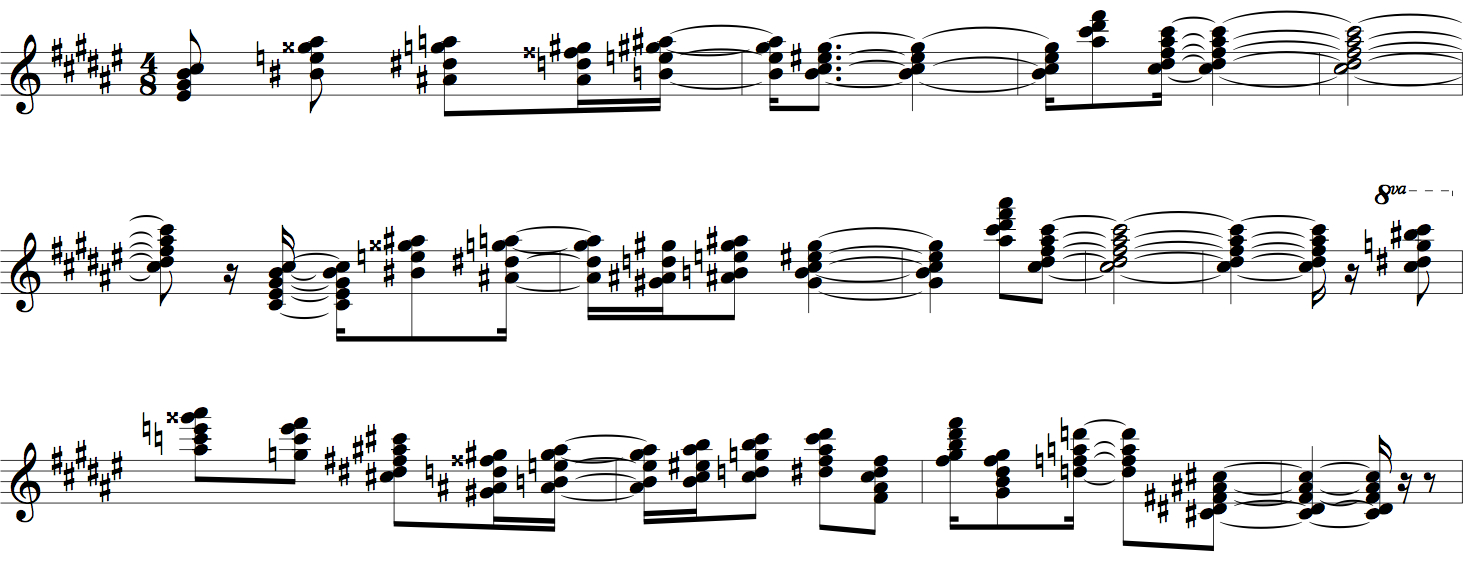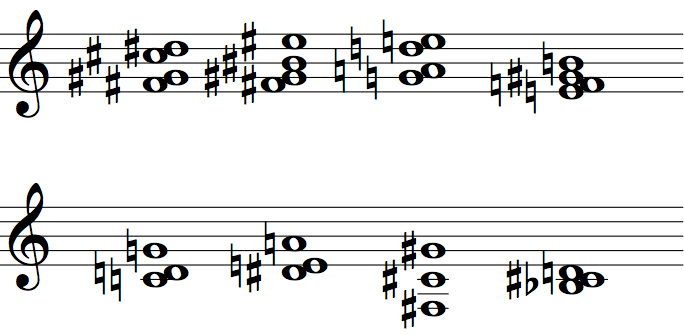The notion of recurring themes also plays a prominent role in his major piano work Vingt Regards sur l'Enfant-Jesus (tr. Twenty Contemplations on the Birth of Jesus), written just a few years earlier. In fact, both works contain a "Love Theme" and a "Chord Theme" which are similar.
- I. Statue Theme
- II. Flower Theme
- III. Love Theme
- IV. Chord Theme
- V. Ragavardhana-Candrakala-Lakskmica Juxtaposition
STATUE THEME
This theme is described by the composer as brutal and oppressive. In its original form, it is played by the trombones in 3rds. Messiaen grew up in Grenoble, France and was impressed by the awe-inspiring, imposing, and almost terrifying presence of the towering French Alps. Many of his more terrifying themes are clearly influenced by this environment.
 |
| The "Statue Theme" in the most primitive of its many guises (also referred to by the composer in the score as the 1st cyclic theme). |
The "Statue Theme" plays a particularly important role in the 5th movement, where it is transformed into a frenetic cosmic dance (shown in my analysis of the 5th movement).
As heard in the 1st movement:
As heard in the 4th movement (looming brass entrance at around 15 seconds into the clip):
As heard in the 5th movement:
As heard in the 7th movement (around 6 seconds into the clip):
As heard in the 8th movement (occurs as a brass canon at around 10 seconds into the clip and then plainly 1 minute in) :
FLOWER THEME
The antithesis/foil of the ominous "Statue Theme". It is quiet and gentle. Messiaen likens it to a blossoming flower. Out of the four cyclic themes identified by the composer, it seems to play a significantly smaller role. The first two measures are played by two clarinets and the third measure is played by flute/bassoon. It appears most frequently in the 8th movement.
 |
| The "Flower Theme" (also referred to by the composer in the score as the 2nd cyclic theme). |
LOVE THEME
Messiaen says that this is the most important of the four cyclic themes he identifies. While the theme itself doesn't occur until the slow 6th movement, variations of the theme play significant roles in the 2nd and 4th movements. It is played both quietly (in the 6th movement) and with full-force (in the 8th and 10th movements). Usually accompanied by garish and colorful harmonies.
 |
| The full "Love Theme" is heard in the 6th, 8th, and 10th movements (also referred to by the composer in the score as the 3rd cyclic theme). |
As heard in the 8th movement as a fragment:
As heard in the 8th movement as an "explosion" (begins at 11 seconds in the clip):
As heard in the 10th movement (begins at 18 seconds in the clip):
 |
| A variation of the "Love Theme" heard in the 2nd movement, played by the saccharine sounds of strings and ondes-Martinot. |
 |
| Another variation of the "Love Theme", played passionately in the second trio of the 4th movement. |
CHORD THEME
This is the most elusive of the four cyclic themes identified, but it is probably the most common. It is a simple chain of four highly dissonant chords, each containing seven pitches.
 |
| The "Chord Theme" (also referred to by the composer in the score as the 4th cyclic theme). It is usually (but not always) played by the piano. |
The "Chord Theme" seems to form a harmonic basis of the work and likely appears in every movement, but I have only been able to locate it in the 2nd, 4th, 7th, 8th, and 10th movements.
RAGAVARDHANA-CANDRAKALA-LAKSKMICA JUXTAPOSITION
One of Messiaen's many musical fixations was Indian rhythms (often referred to as "talas", although I admit that I have been using that term too loosely). He collected a series of ancient Indian rhythms and often used them as what he called a "rhythmic pedal" -- that is, a series of repetitions played over other material. Three talas which he seemed to be particularly fond of are the Ragavardhana, the Candrakala, and the Lakskmica. Not only that, but he specifically liked the result when the three were juxtaposed in that order, hence the title of the theme. It occurs in several of his early works, including Quatour pour le Fin du Temps (tr. Quartet for the End of Time), Vingt Regards sur l'Enfant-Jesus (tr. Twenty Contemplations on the Birth of Jesus), and Visions de l'Amen (tr. Visions of the Amen).
Like his student, the maverick German composer Karlheinz Stockhausen, Messiaen had a strong dislike of steady pulses. This rhythm is used to keep a beat, however unsteady. Within the Turangalila-Symphonie, the theme occurs in the fourth, fifth, seventh, and tenth movements (and perhaps more that I have yet to find). The Ragavardhana and Lakskmica also appear independently in the first movement (shown in my analysis of the 1st movement).
As heard in the 4th movement (played clearly by woodblock starting at 4 seconds into the clip):
As heard in the 5th movement (very difficult to pick out, but it played by the cymbal and triangle):
As heard in the 7th movement (again very difficult to pick out among the cacophony, but it is played by the piano where the two hands are in a rhythmic canon):
As heard in the 10th movement (played clearly by woodblock and cymbal from the start):
 |
| The Ragavardhana-Candrakala-Lakskmica Juxtaposition plays a major role in Messiaen's music. |
Like his student, the maverick German composer Karlheinz Stockhausen, Messiaen had a strong dislike of steady pulses. This rhythm is used to keep a beat, however unsteady. Within the Turangalila-Symphonie, the theme occurs in the fourth, fifth, seventh, and tenth movements (and perhaps more that I have yet to find). The Ragavardhana and Lakskmica also appear independently in the first movement (shown in my analysis of the 1st movement).
As heard in the 4th movement (played clearly by woodblock starting at 4 seconds into the clip):
As heard in the 5th movement (very difficult to pick out, but it played by the cymbal and triangle):
As heard in the 7th movement (again very difficult to pick out among the cacophony, but it is played by the piano where the two hands are in a rhythmic canon):
As heard in the 10th movement (played clearly by woodblock and cymbal from the start):
No comments:
Post a Comment